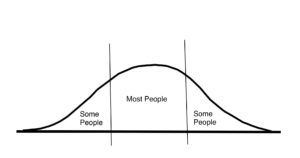Recently, I have been drawing my clients attention to something you notice when you spend many hours in the gym every day. Gyms are a good place to see a bell curve.
The Bell Curve
Just as a refresher, a bell curve is a distribution of a variable. The peak at the top of the curve is the most probable event. On either side of the peak there is a slope away showing an ever smaller probability. The major concept for our purposes is that the more extreme the event, the less likely it is.
Physical Responses To Exercise Fall On The Bell Curve
The gym that I work at serves a very homogenous population. There aren’t really any body builders, all ages are represented, and general fitness is what most people are looking for. Most of the people do similar workouts. After all, they are exposed to the same sources of fitness information as everyone else (unless they happen to work with a trainer).
You can see the bell curve at work by looking at the physical results that this relatively homogenous group displays. Some people get very large results. They seem to have no trouble gaining muscle or staying slim and they just seem to get ripped. The overwhelming majority of people show moderate results. They get better at the workouts, they drop a few pounds – maybe – and they tone up a little. Some people struggle, and often end up leaving.
What They Do In The Gym Isn’t What Makes The Difference
The point I am most interested in making here is that no one (in the general population) is getting an amazing physique because they have the secret recipe. I observe a lot of people working out, both members and fitness professionals, and most everyone does very similar things. Nevertheless, the physical results vary wildly.
This is not to say that your workout program doesn’t matter. On the contrary, what you do in the gym makes a tremendous difference in your health and well-being. It’s just that the part we most notice, the aesthetic part, is far less under our control than we acknowledge. A well designed workout is good for you. But exactly how and to what degree your body is going to respond to it, particularly with regards to physique, comes out on the bell curve. Some people just look at a dumbell and their arms grow two sizes. Other people work hard and see modest gains. Some people work out all the time and their physique never really changes.
It Is Still Important, And Worth It
I do not write this to be a downer. Rather, I have three points to make. Point number one is that we should not constantly chase the magic program. There is a lot of bouncing around in fitness. We go from pilates, to yoga, to group fitness, to spin, from paleo, to atkins, to gluten free, to vegan. Each time, we hope that the miracle will finally happen and we will transform. I really think that is just not the reality.
The second point is that if we consider that we have less control over where we will fall on the curve, we can stop focusing only on chasing the result and spend more time on the process. Exercising is about improving. You want to improve your health. To do that you need to work on many things like your cardiovascular capacity, your flexibility, your strength, and by working on your overall well-being from your sleep habits to your stress levels. Each one of those things can be improved systematically and over time, but it will take one person longer than the next to see those changes, and the ultimate degree will vary as well. That doesn’t make it less important, or less rewarding.
Finally, I think this can help us all be more accepting of ourselves and each other. Not everyone is going to have a super-hero body, no matter how hard they work. Not everyone who is bigger than society dictates is making all the wrong choices. And those of us who fall in the middle needn’t constantly obsess about how to get to, or avoid getting to, either of the extremes.
If we can keep all that in mind, we can be much more effective at improving our health.

Thanks for a well thought out article. We can all improve, and do good for ourselves, in small or large ways, whether we are small or large, younger or older, or have various health conditions.